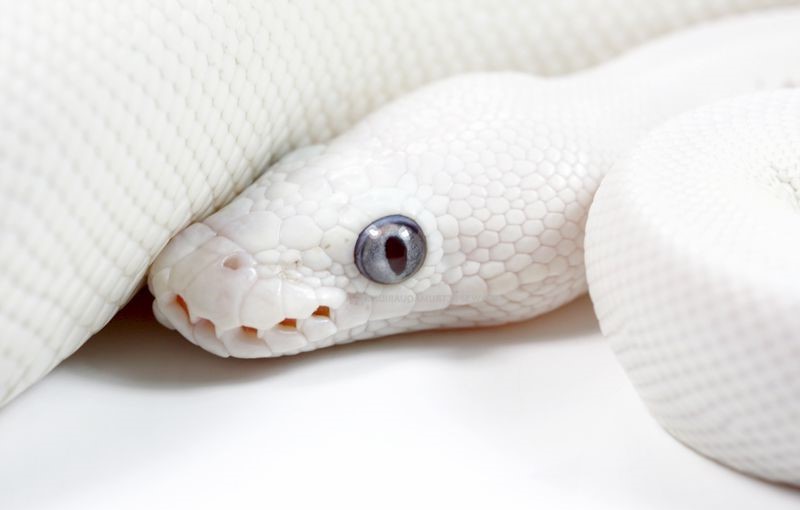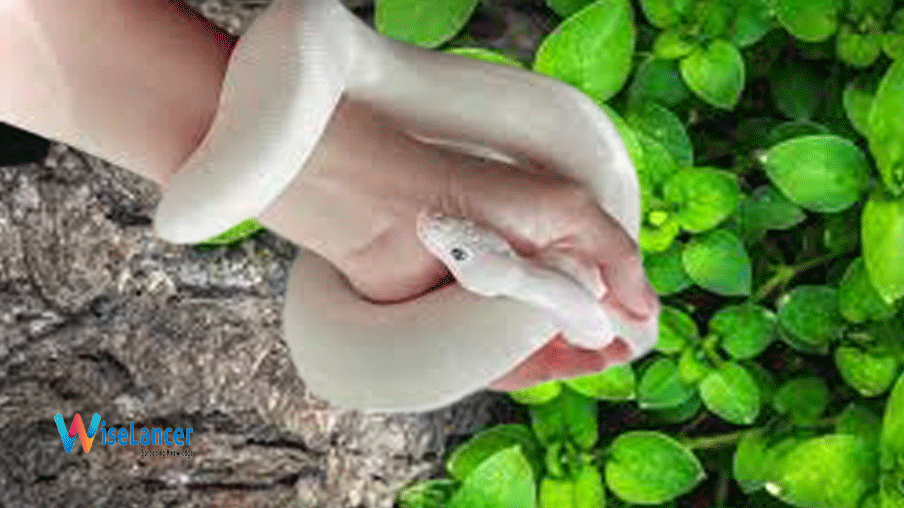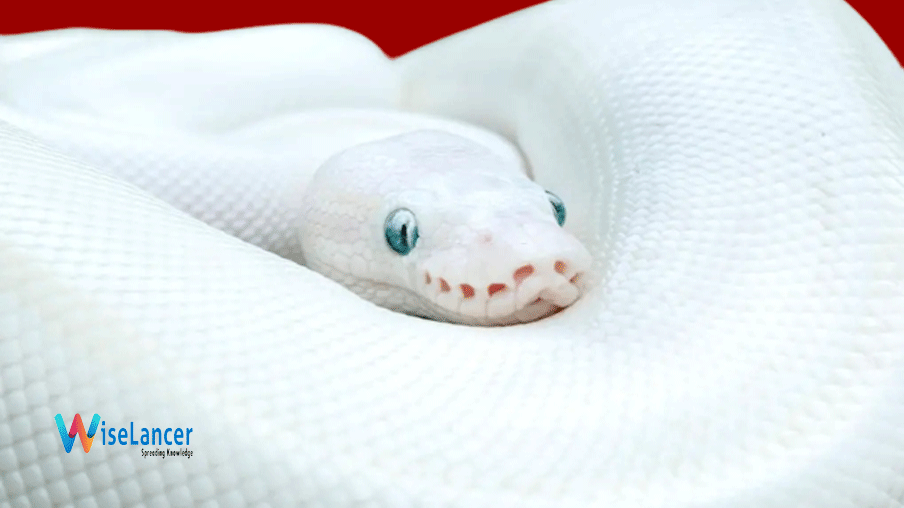Blue Eyed Leucistic Python?
This Blue Eyed Leucistic Python is one of the rarest forms of the Royal Python!
It comes from a cross between two phases of royal pythons. In general, the crossing is between the Mojave, Lesser or Butter phases.
Due to the color of its eyes, it is not classified as an albino snake, but its body is devoid of pigmentation.
It can reach up to 1.5 m long!
The blue-eyed Lucy is one of the rarest forms of the ball python and is a highly prized reptile.
This morphology tolerates handling and adapts well to captivity. They are perfect for any herpetologist who wants a unique reptile.
What is a Blue Eyed Leucistic Python?
Known as the bell ball python, it is a white ball python.
It is a white color snake with icy blue eyes and black pupils. Due to their eyes, they are not classified as albino snakes, but their bodies are barren of pigment.
These docile snakes can grow up to 1.5m in length and are perfect for new owners.
Their history is deeply rooted in that of the common ball pythons of Africa.
Ball pythons are native to grasslands and forests in West and Central Africa and became popular with herpetologists during the 1980s.
The first recessive gene was isolated in 1992 by professional snake breeders. And they succeeded in bringing the first clutch of morphs.
Breeders have since come across thousands of morph combinations, and the blue-eyed leucistic ball python is one of them. They can be expensive and hard to find – breeders typically charge $700 per snake.
What Makes A Blue Eyed Leucistic Python?
This snake is very complicated to raise and comes from two of the five morphs: Mojave, Butter, Lesser, Het Russo and Phantom. The most commonly used genes are Mojave, Butter, and Lesser.
They need two different morph genes bred over three generations.
Here are Some Examples of Breeding Pairs:
Mojave and Lesser
Butter and Mojave
The Ghost and the Butter
These morphologies are challenging to produce. They are called designer pythons because they are considered nearly impossible to occur naturally in the wild.
What We Love About BEL Ball Pythons For
Ball pythons are a popular pet and well-established.
They are docile and tolerate handling well.
This morphology is extremely unique and rare.
Cons
They can be picky eaters in the cool season.
This body type is very expensive to buy – $400 to $600.
This species is shy and can get stressed easily.
The Appearance of the Species
Their dark pupils help them less sensitive to changes in light compared to albino breeds.
To identify the classic ball python, you need to notice its skin. It is a brittle white snake without any pigmentation or pattern on the skin. They have inimitable icy blue eyes and look extremely unique.
But, ball pythons may vary in color as some off-white to white snakes have pale tan-yellow bands. Due to their undesirable color and bands, they are considered less unique. However, these pythons are similar to classic ball pythons in terms of genetics and appearance.
They have small spurs on the sides of their vent which are said to be the remnants of the vestigial legs of their ancestors.
How Big Can a Blue-Eyed Leucistic Python Get?
Males and females are slightly different from each other in terms of length. Generally, males can reach to two meters tall in two or three years. But, females can go five to six meters tall. This is the main difference between the two genders of the ball python.
Despite their white body and different appearance, this body type’s growth is the same as that of their wild-type relatives.
The young are born with a size of 25 cm and take three years to reach their adult size.
Females have a longer growth period due to their size difference.
It is important to remember that ball pythons are extremely susceptible to being overweight. The reason is their stocky bodies and deskbound behavior. Male and female ball pythons also vary in weight. A male weighs approximately 1600 grams and a female weighs 1800 grams. But, some hale and hearty females can weigh more than 1900 grams.
You should check your snake’s weight regularly to ensure that it maintains a healthy size.
Blue-eyed leucistic python care sheet
The royal python is a docile snake, ideal for beginners.
If this beautiful beginner snake has caught your eye, read on to find out how you can bring one home and give it a wonderful life.
Royal Python Diet
Ball pythons are carnivorous in the wild and prey on small rodents and birds.
The diet of the blue-eyed leucistic python is very simple – hatchlings should be fed pink or fluffy mice, and adults – rats. Besides what to feed your snake, you need to know when to feed it and how much. This changes as your snake ages:
Pups should eat pink or fluffy mice every five to seven days.
Youngsters (from six months to three years) should be fed every seven to ten days with rodents. Medium-sized rates are ideal to give as a portion of food to ball pythons every 10 days.
Hatchlings are fed pink or fluffy mice, as the higher fat content of mice may prevent them from transitioning to rats as juveniles.
We strongly recommend that you only feed frozen-thawed food.
Other insects or live prey can cause trouble for your snake in the form of infection or eye damage. So, you should keep your ball pythons away from these live prey.
You Need To Get Rodents Out:
Before feeding your snake, you can keep a rodent in your fridge. Then take a bag and place the rodent in it. Place it in warm water before feeding. Once it gains 97 to 100 degree Fahrenheit temperature, you can feed it to your snake.
However, live prey can be healthy for your snake as it can provide them valuable nutrition. But, you can also feed a chick every week.
Finally, keeping a bowl of water large enough for your snake to soak in is important. This will help them shed and maintain their hydration. You should clean once every two days to prevent any mold growth.
Known Health Issues:
Ball pythons are known to have a very long lifespan of 20 to 30 years. Known as the oldest in captivity is 48! Blue-eyed leucistic ball pythons have the same lifespan.
This is one of many designer pythons that rarely exhibit genetic issues such as head wobbles.
However, these morphs are still prone to health issues related to life in captivity:
After buying a snake, you can choose to quarantine it to ensure it is healthy. The quarantine must last 90 days.
You can also contact a veterinarian for tests such as fecal exams, blood work, and X-rays to determine if there are any health issues.
During quarantine, you should also note the frequency of soaking.
If you have a non-aquatic snake that drenches daily, it could indicate that it has mites and is trying to drown them. Mites are easily spread during transport, so they must be eradicated before introducing a new snake to your collection.

Signs They are Healthy
Hangars come off in whole pieces with eye caps.
Night exploration.
Signs they are healthy
Hangars come off in whole pieces with eye caps.
Night exploration.
Eat on time.
Obedient behavior.
Disease symptoms
Increased warm-up.
Wheezing or clicking noises.
Refusal of prey.
Too much soaking.
Enclosure for blue-eyed leucistic python
Ball pythons are native to African grasslands.
Ram pythons have the same primitive instincts as their wild counterparts and need the same enclosures.
Here are a few key points to consider before sharing tank sizes and configurations:
Do not place the Ball pythons tank right in front of the sunlight as it might overheat.
The tank should have a smoothing area in addition to the heater.
This species is shy, so you should provide plenty of hiding places and cabins.
Enclosures for ram pythons should be exactly the same as those for other ram pythons.
It should be made of PVC, plastic, or glass and should have a sturdy lid. Using PVC is the best solution as it gives your snake more privacy. Plastic also retains moisture and keeps temperatures consistent better.
Glass terrariums can work, but they require more faux foliage and skins. In order to make your snake feel good and safe, you can consider glass terrariums. But, it requires plenty of skins and faux foliage.
Tank Size
Hatching goes perfectly well in a 10-gallon pen.
Juveniles will thrive in a 20-gallon.
Adults should be in a 40-gallon tank.
Adding hatchlings or juveniles to a 40-gallon adult-sized tank will bring stress to them.
Inside their tank, you require a minimum of two skins – one on each end. The more, the better. Add plants, sticks, bark, moss and other items to make them feel safe as they venture outside.
Tank Configuration
Tank type: plastic or PVC.
Adult Tank size: 40 gallons.
Lighting: sunlamp.
Substrate: cypress mulch or organic topsoil.
Your snake should be able to bask in an area of 88-92°F during the day.
To do this, buy a heat lamp connected to a thermostat. You can use the heat lamp to maintain a cycle of light that will allow them to maintain their internal rhythm.
The basking area must be located at the end of the tank, not in the center.
The cold side of the pen should be 76-80°F with an ambient temperature of 82-83°F in between. It is best to use a ceramic heat emitter which will provide consistent heat even when the tanning lamp is off.
It will be ideal if you maintain constant humidity of between 50 and 60%.
If the humidity is 80% (or higher) for an extended period of time, it can cause a respiratory infection. A hygrometer is needed to monitor humidity and choosing a good growing medium will help maintain it.
The best substrates for blue-eyed leucistic ball pythons are those that retain soil and moisture. This can be cypress mulch or any organic, non-perlite topsoil. Both of these choices retain moisture and help maintain humidity.
Cleaning and Misting:
It is imperative to clean the enclosure of your snake every 6 weeks. You should clean the excrement on a daily basis in order to maintain a clean atmosphere.
To identify the ration of urates and feces, you can also consider spot cleaning. It helps you to identify their stools so that you can find the root of any problem.
Try to mist your ball python on a regular basis with suitable humidity.
If the humidity level decreases below 40 percent, then you should mist your ball python regularly.
In order to oversaturate the substrate, you can mist repeatedly. But, you have to clean the enclosure on a regular basis. By adding a drainage system, you can keep the soil moist if you face this issue.
Typical Behavior of Blue Eyed Leucistic Python
During day time, ball pythons become sedentary because they don’t like the heat and sun. Due to this reason, they hunt at night and find mates.
These snakes avoid each other in nature and only interact with each other when breeding.
It is not recommended to cohabit this species.
If we talk about blue-eyed ball pythons, they utilize constriction to pacify their prey because they are dangerous and active hunters.
These ball pythons wrap tightly and quickly around their prey and in order to kill them. During the winter, their metabolism works nominally because they don’t feed during these months.
During the cool season, they usually stop feeding for several months and their metabolism slows down.
So, any change in temperature or humidity can activate a feeding strike in your snake, especially if they are in captivity. Most morphs will resume feeding on themselves as soon as conditions return to normal.

Do Pythons Like to be Handled?
Its friendly temperament and tolerance for handling make it an ideal snake for beginners.
After you bring your blue-eyed leucistic python home, it will need a few days to adjust. To prevent your snake from being overly stressed, minimize interactions for the first two weeks.
After touching your snake or any reptile, you should clean your hands. This is essential to reduce the risk of salmonella, which is a disease.
In order to handle your ball python, you can start with a ten-minute session. If your snake can tolerate it, then you can increase the duration.
Important Tips for Getting Started with Your Blue Eyed Leucistic Python:
Rub your snake’s skin, especially back gently with your hand.
If your snake tries to curl up or shakes his head, then it means he is in stress or fear.
Pick up the snake by the widest part of its body.
Support the rest of the snake’s weight when you pick it up.
This species is like any other snake and is capable of biting. However, she rarely bites and is docile and even-tempered.
These non-venomous constrictors are not capable of inflicting a severe bite.
If you notice the snake is shedding or has eaten within the last 22 hours, do not handle it.
To avoid confrontation, don’t force a negative interaction.
How Much Does A Blue-Eyed Leucistic Python Cost?
Most ram pythons are priced between $400 and $600.
If a snake has beige dorsal stripes, it will be cheaper. However, Stark White Snakes can cost upwards of $600.
At birth, this species measures about 10 inches and appears a translucent pinkish-white. Eventually it turns white.
Blue-eyed leucistic ball pythons are hard to find because they are very difficult to breed.
Finding reputable breeders is even harder.
When choosing a blue-eyed leucistic python, be sure to check it for scars, wounds, mouth rot, or scale rot. If their ribs are tilted downward at a dramatic angle, they are malnourished.
These long-lived snakes are a marvel for any reptile collection.
Need Help or Advice in Academic Writing
See Samples
https://independent.academia.edu/shamsulIslam8
Need Help or Advice in Content Writing Management:
Would you like more advice? Do you have good practices to share? Please feel free to express yourself in the comments. Also, if you want help in writing content to drive more traffic and boost conversions, please get in touch through Contact our team or send your requirements here.
Do you want help writing quality content, driving traffic to your website, and boosting conversions? You can contact me through my Freelancer.com profile. I always prefer to work through my Freelancer.com profile for smooth functioning. Here, you pay safely and securely.
Read More:
THE 51 MOST STUNNING PLACES IN THE WORLD
6 AMAZING SOCIAL MEDIA TRENDS AND TIPS FOR FEBRUARY 2023
EAT ONE PIECE OF ROASTED GARLIC AND GET AMAZING RESULTS
